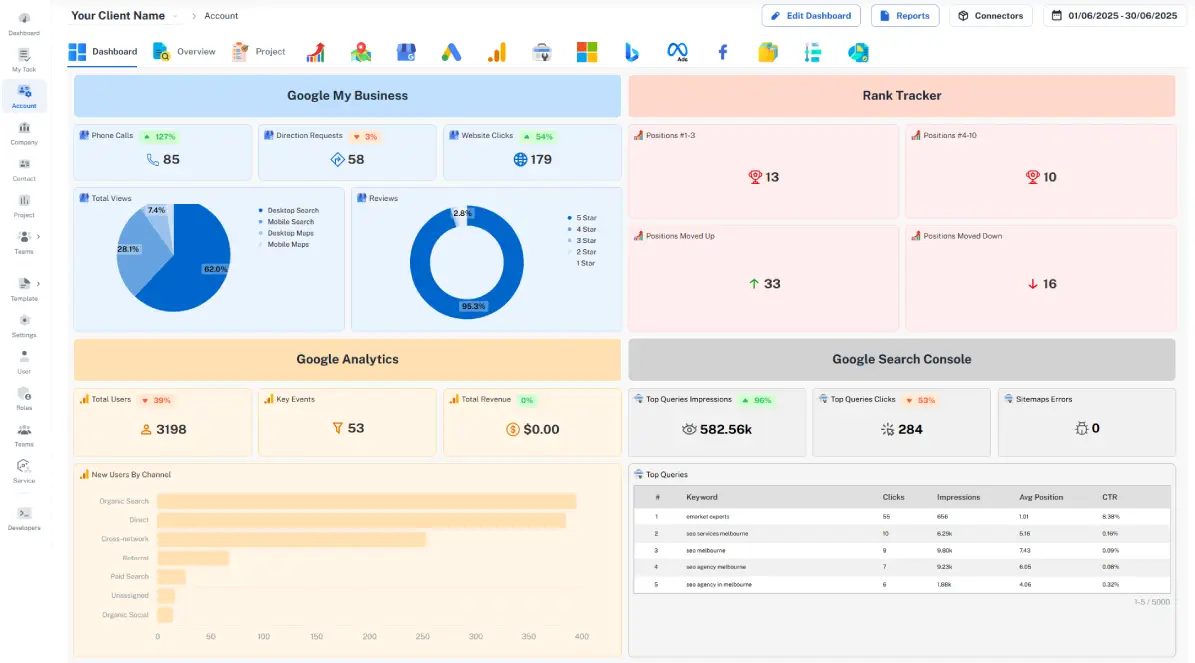Table of Contents
- Traffic & Visibility Metrics
- 1. Organic Traffic
- 2. Mobile Traffic
- 3. Indexed Pages
- 4. Keyword Rankings
- 5. Local Map Rankings
- 6. Impressions & Average Position (GSC)
- Technical SEO Metrics
- 7. Site Audit Score & Errors
- 8. Crawl Errors
- 9. Page Load Time & Core Web Vitals
- 10. Mobile Usability
- 11. HTTPS Implementation
- 12. XML Sitemap & Robots.txt Validity
- Engagement & User Experience Metrics
- 13. Bounce Rate
- 14. Click-Through Rate (CTR)
- 15. Average Session Duration
- 16. Pages per Session
- 17. Engagement Rate (GA4)
- 18. Scroll Depth
- Authority & Link Metrics
- 19. Backlink Profile
- 20. Referring Domains
- 21. Domain Authority / Domain Rating
- 22. Anchor Text Distribution
- Conversion & Business Impact Metrics
- 23. Conversion Rate (leads, sales, form fills)
- 24. Goal Completions (GA)
- 25. Call or Chat Interactions (Conversation Rate)
- 26. Lead Quality or Value
- Competitor & Market Benchmarking
- 27. Competitor Keyword Rankings
- 28. Share of Voice (SERP Visibility)
- 29. Backlink Gap Analysis
- 30. Content Gap Analysis
- Wrapping Up
Imagine trying out a new SEO dashboard. It looks great and promises all the usual stuff like time savings, clear insights, happier clients. But when it comes time to build reports, you rudely discover that basic things are missing.
- Bounce rate? Not there.
- Keyword rankings? Only a few.
- Mobile performance? Nowhere to be found.
- Competitor analytics? Missing in action.
That’s when you realize that a dashboard is only as good as the data it can present. It isn’t just about the number of metrics, but the right metrics.

Here are the top 30 metrics your SEO dashboard should track, why each one matters, and how to track them using DAXRM.
Traffic & Visibility Metrics
Let’s start with the obvious: traffic.
If nobody’s landing on your site, none of the other metrics matter.
These visibility signals reveal how well your SEO is pulling in visitors, be it from search results, map packs, or mobile devices.
1. Organic Traffic
This tells you exactly how many people Google sends to your site organically (without clicks on ads).
If you watch it climb, good job! That’s your SEO driving traffic.
If it drops, you’ll need to dig in, which could mean checking rankings and switching between tabs a trillion times.
DAXRM saves you the hassle by pulling real-time organic session data straight from Google Analytics—no extra reports, no tab trouble.
2. Mobile Traffic
It’s been a while since Google switched to mobile-first indexing. Since 2016, your mobile site has been considered the main version by Google. Why? Because over 60% of all traffic now comes from mobile devices.
For any agency, it’s crucial to know how much of a client’s traffic comes from phones and tablets, and which devices in particular. That way, you can fine-tune how the site looks and performs on mobile.
If your mobile version is weak, you risk losing most of your visitors. With DAXRM, you can filter by device in seconds to spot performance gaps and prioritize the right fixes.
3. Indexed Pages
This rank number shows how many of your URLs Google has stored. When it drops, it means something broke. Maybe it’s a misconfigured robots.txt or a bad no-index tag, who knows? DAXRM can help you find out what went south!
Our digital agency SEO reporting tools syncs with Google Search Console to show real-time indexing counts so you catch issues fast.
4. Keyword Rankings
These show you exactly where your site stands in Google’s search results for the keywords that matter most.
For example, you might be ranking #1 for “yoga pants discount” but nowhere for “yoga classes in Melbourne”. Such achievements are great for vanity, but not for business.
A tool that’s worth investing must track the rankings of your most important keywords daily. DAXRM does the needful by connecting to reliable rank tracking tools with AI Overviews & SERP Features.
You’ll see position changes across devices (mobile vs. desktop) and regions, so you can adjust your content, targeting, or link-building strategy with precision.
5. Local Map Rankings
If you’re working with businesses that depend on location-based searches—like cafés, dentists, gyms, or real estate agents—then showing up in Google’s Map Pack is a big deal.
That top-three local listing you see when someone searches "pizza near me" can make or break foot traffic.
You might be doing well in regular search results but still missing out locally if you’re not tracking Map Pack rankings. That’s where DAXRM helps.
Its geo-targeted tracking lets you monitor local positions by city, ZIP code, or even radius. So if your client’s HVAC service ranks well in downtown Houston but vanishes in the suburbs, you’ll spot the gap quickly and take action.
Whether it’s more reviews, GMB updates, or local landing pages, now you’ll know where to interfere.
6. Impressions & Average Position (GSC)
Think of impressions as how many times your pages show up in search results, even if no one clicks.
It’s like waving at someone across the street—they may not wave back, but at least they saw you.
Now compare that with ‘average position’, which tells you where on the page you're showing up.
Position 3? Great. Position 47? Not so much.
With DAXRM’s Google Search Console (GSC) integration, you can view both metrics side by side. Makes it so much easier to spot if your content is being seen but not clicked.
Is it weak titles, poor meta descriptions, or irrelevant targeting? Either way, you’ll know where to tweak for more visibility and clicks.
Technical SEO Metrics
Technical metrics don’t always get the spotlight, but they keep your SEO engine running smoothly.
You might have killer content, but if Googlebot can’t crawl your site or your pages take 10 seconds to load... well, nobody’s sticking around to read it.
7. Site Audit Score & Errors
Your site might look great on the surface, but under the hood, it could be full of issues such as broken links, duplicate content, missing meta tags, or worse.
The site audit score is like a health check-up for your website, and if the score is low, don’t expect Google to trust you with top rankings.
DAXRM helps you keep an eye on these issues by letting you embed Looker Studio widgets that pull audit results from tools like Screaming Frog or SEMrush.
That means you see exactly what’s wrong and where to start fixing.
8. Crawl Errors
If Google can’t crawl your pages, they won’t rank. It’s that simple. That’s why monitoring crawl errors is a must.
Using your dashboard’s Search Console integration, you can quickly spot 404s, server errors, or blocked pages—then fix them before they snowball into bigger problems. No more guessing what went wrong or digging through logs manually.
9. Page Load Time & Core Web Vitals
Nobody likes a slow website. If your pages take forever to load or jump around as they render, visitors bounce and rankings fall.
That’s where Core Web Vitals come in:
- LCP (Largest Contentful Paint) measures how fast the page actually loads,
- CLS (Cumulative Layout Shift) tracks layout stability, and FID (First Input Delay) checks responsiveness.
The good news? You can track all of these right inside your dashboard by connecting PageSpeed Insights or Looker Studio.
Once hooked up, you’ll see exactly which pages need help—and how those fixes impact engagement.
10. Mobile Usability
If your site’s buttons are too close together, the text is barely readable, or the layout is all over the screen, it’s a problem for users as well as search engines.
Mobile usability issues are flagged in Search Console, and when plugged into your dashboard, they’re easy to spot and resolve.
No need to wait for a client to complain. Just jump in, fix what’s broken, and keep both visitors and Google happy.
11. HTTPS Implementation
If your site still runs on HTTP, Google’s already penalizing you. And so are your users. That little padlock in the browser bar is not just a nice-to-have anymore—it’s a ranking factor.
HTTPS ensures that your visitors’ data is encrypted, secure, and trustworthy. Without it, browsers start flashing scary warnings, and bounce rates go through the roof.
Luckily, it’s easy to track whether your pages are properly secured. Your SEO dashboard should flag any non-secure URLs or mixed content (where images or scripts still load over HTTP).
12. XML Sitemap & Robots.txt Validity
Missing sitemap entries? Accidentally disallowed key pages? These things happen more often than you’d think—especially after site migrations or CMS updates.
Your dashboard should check for errors, missing files, or crawl-blocking lines in robots.txt. Bonus points if it pulls in Search Console data to confirm everything’s being indexed as expected.
Engagement & User Experience Metrics
Now that people are landing on your site, what are they doing? These metrics help you figure out if your content is engaging or if users are bouncing back.
13. Bounce Rate
This one’s pretty straightforward—it tells you how many visitors land on a page and leave without clicking, scrolling, or engaging.
Sometimes, a high bounce rate is fine (like on a quick-read blog post that gave them exactly what they needed). But if it’s happening on a service or landing page? That’s a red flag.
To fix it, you might need to tighten up your messaging, tweak the layout, or add a clearer call to action.
Your dashboard can show bounce rates by URL, so you’ll know exactly which pages need attention, and which ones are doing well.
14. Click-Through Rate (CTR)
CTR shows how many people saw your page in Google and decided it was worth a click.
If impressions are high but CTR is low, something’s off. Maybe your title tag is flat, your meta description’s too vague, or your snippet just doesn’t stand out.
Instead of guessing, you can track CTR alongside keyword rankings to spot underperformers.
For example, if you're in position 3 for “custom kitchen cabinets” but getting a 1% CTR, you’ve got room to improve.
A fresh title or a punchier description might be all it takes to pull more clicks.
15. Average Session Duration
This tells you how long people actually stick around on your site. If visitors are bouncing after 10 seconds, that’s a red flag—maybe your content isn’t hitting the mark, or your site takes forever to load.
With DAXRM’s SEO dashboard, you can see the average session duration alongside bounce rate.
Your dashboard pulls the metric straight from GA4 and layers it with engagement metrics, so you can spot which pages are keeping or driving away visitors.
16. Pages per Session
This one’s about how sticky your site is. How many pages someone checks out before leaving your site.
If users only view one page and vanish, your internal linking might be weak, or maybe there’s just no reason to keep clicking.
On the flip side, if they’re jumping from your blog to your services to your pricing page, you’ve got their attention.
Want to see what actually keeps people exploring? Platforms like DAXRM let you break this down by campaign or entry page.
You can track which types of content lead to more pageviews and fine-tune your linking strategy, so the user’s journey doesn’t end before it begins.
17. Engagement Rate (GA4)
Say goodbye to bounce rate (well, sort of) and hello to Engagement Rate—GA4’s newer, more nuanced way to measure whether people are actually doing something on your site.
An “engaged session” means someone scrolled, clicked, converted, or stuck around for more than 10 seconds. In other words, they didn’t just pop in and bounce.
This metric is now a key indicator of how sticky your content really is. And with tools like DAXRM, you can pull this into your dashboards without fuss.
18. Scroll Depth
Want to know if people are actually reading that 2,000-word blog post? Scroll depth tells you if they even made it past the first third. This one's optional, but really helpful for content strategy.
If folks only scroll 25%, maybe your intro needs work—or your subheadings are putting them to sleep.
While DAXRM doesn’t track this natively, you can connect GA4 custom events or tools like Hotjar to visualize the data alongside other SEO metrics.
Authority & Link Metrics
19. Backlink Profile
Backlinks still matter—a lot. They tell Google other people trust your site, so it should rank you higher than another website that hasn't as many links pointing to its pages. But, there’s a catch. Not all links are created equal.
Low quality links can do more damage than good. A solid backlink profile tracks new links, lost ones, and the quality of each.
Think of it like social proof—if 20 high-authority websites link to your guide on digital marketing, it’s like getting endorsements from industry pros.
20. Referring Domains
This metric zooms out from individual links and shows how many unique sites are linking to yours. More diversity means more trust in Google’s eyes.
If all your backlinks come from three domains, it’s not a great look. DAXRM-style dashboards track domain growth over time so you can see if your PR and outreach efforts are actually paying off.
21. Domain Authority / Domain Rating
These scores (from Moz and Ahrefs respectively) aren’t official Google metrics, but they’re widely used in SEO to estimate how strong your domain is. The higher it is, the easier it becomes to rank.
Tracking DA or DR helps you benchmark your site and competitors over time. Just remember—this number moves slowly, so don’t sweat the day-to-day. Instead, use it to track long-term growth from content and backlink efforts.
22. Anchor Text Distribution
Anchor text is what people actually click on in a link. It gives search engines clues about what your pages are about. But if 90% of your backlinks use exact-match keywords like “cheap car insurance,” it looks spammy.
Healthy anchor text distribution includes branded terms, naked URLs, and a mix of generic and targeted keywords. Dashboards that let you visualize this can help you course-correct before Google gets suspicious.
Conversion & Business Impact Metrics
23. Conversion Rate (leads, sales, form fills)
Traffic is great, but if no one’s buying, signing up, or reaching out, you’ve got a leaky funnel. Conversion rate is one of the most important SEO metrics because it ties your efforts to actual business outcomes.
You can track this via GA4, and in DAXRM dashboards you can map it to specific landing pages, channels, or campaigns to see what’s really pulling its weight.
24. Goal Completions (GA)
Whether it’s a newsletter signup, a quote request, or a purchase, setting up goals in GA means you can track them without second-guessing. It’s a way to measure micro and macro wins.
Dashboards that integrate with GA make it easy to see trends, compare across time periods, and spot which pages are converting—and which ones need love.
25. Call or Chat Interactions (Conversation Rate)
For service businesses especially, calls and chats are gold. If someone hits “Call Now” or opens your live chat, they’re showing real interest.
Tracking how many visitors take that step can help you optimize CTAs and understand user behavior.
Many CRMs or call tracking tools can feed this data into your dashboard, so you can measure these soft conversions alongside form fills and purchases.
26. Lead Quality or Value
Getting a bunch of leads sounds great, until you realize most of them aren’t serious.
One client might get 100 form fills, but only 10 are actually worth following up. That’s why it’s important to track not just how many leads you’re getting, but how valuable they are.
If your dashboard connects to a CRM like HubSpot or Pipedrive, you can tag leads by quality or deal size and bring that data back into your reports.
This helps you focus on what really matters: leads that convert into revenue, not just empty numbers.
Competitor & Market Benchmarking
27. Competitor Keyword Rankings
Want to know where your competitors are winning? Track their keyword positions.
Maybe they’re outranking you for “SEO agency near me” but not “SEO services for law firms.” That’s a chance to strike.
Tools like SEMrush and Ahrefs let you keep tabs on their rankings, and pulling that into your dashboard helps you adapt your strategy faster.
28. Share of Voice (SERP Visibility)
Share of voice shows how much visibility your site has in Google search results compared to your competitors—for the keywords that matter most to your clients.
Think of each Google search result page like a piece of digital real estate. If your site appears in the top spot, that’s one plot of land. If you’ve also got a featured snippet, video, or a spot in “People Also Ask,” you’re owning more of that valuable screen space.
The more real estate you control, the more likely you are to get the clicks. Platforms like DAXRM can track this across your keyword set and show your visibility share as a percentage.
29. Backlink Gap Analysis
This metric allows you to compare your backlink profile to your competitors and see which sites are linking to them but not to you. Then, you build a list of opportunities.
If a top-ranking competitor got featured on a local blog or niche directory, why shouldn’t you? DAXRM dashboards that sync with tools like Ahrefs can highlight these gaps automatically.
30. Content Gap Analysis
Same idea, but for keywords and topics. What are your competitors ranking for that you’re not even targeting?
A good content gap analysis tells you what you’ve missed—and what you should write next. You can even filter by keyword intent or search volume to focus on high-impact gaps.
When added to your dashboard, this becomes a running to-do list for your content team.
Got it! Here’s a concise, on-brand conclusion to wrap up the entire blog post:
Wrapping Up
Tracking SEO metrics isn’t just about proving your work. It’s also about sharpening your strategy, winning more traffic, and showing clients exactly where the value lies. When you know what to measure (and how to measure it), your decisions get smarter, your reporting gets easier, and your results start compounding.
With tools like DAXRM, you don’t need ten tabs and five spreadsheets. Just one place where all your metrics live—clean, connected, and client-ready.
Ready to turn your SEO reporting from “meh” to mission-critical? Start with the metrics that matter. Let your dashboard do the heavy lifting.


